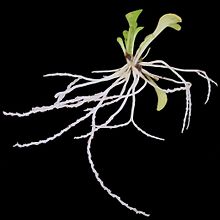Our website is made possible by displaying online advertisements to our visitors.
Please consider supporting us by disabling your ad blocker.
Genlisea
| Genlisea | |
|---|---|

| |
| Genlisea violacea leaves: green above-ground leaves and colorless underground trap leaves | |
| Scientific classification | |
| Kingdom: | Plantae |
| Clade: | Tracheophytes |
| Clade: | Angiosperms |
| Clade: | Eudicots |
| Clade: | Asterids |
| Order: | Lamiales |
| Family: | Lentibulariaceae |
| Genus: | Genlisea A.St.-Hil. (1833) |
| Subgenera and sections | |
| |

| |
| Global distribution of Genlisea | |
Genlisea (/ˌdʒɛnlɪˈsiːə/ JEN-liss-EE-ə) is a genus of carnivorous plants also known as corkscrew plants. The 30 or so species grow in wet terrestrial to semi-aquatic environments distributed throughout Africa and Central and South America. The plants use highly modified underground leaves to attract, trap and digest minute microfauna, particularly protozoans. Although suggested a century earlier by Charles Darwin, carnivory in the genus was not proven until 1998.[1]
The generic name Genlisea honors the French writer and educator Stéphanie Félicité Ducrest de St-Albin, comtesse de Genlis.[2]
Several species in the genus, including G. margaretae, G. aurea, and G. tuberosa, possess the smallest known genomes of all flowering plants.[3][4][5]
As stated, Genlisea has a wide range of genetic diversity which can be shown in various phenotypic traits. For example, G. tuberosa develops tubers, one to three occurring per plant. This allows for carbohydrate and water storage as it is found in areas prone to fire. Other species present with a thickened stolon.[6]
- ^ Barthlott W, Porembski S, Fischer E, Gemmel B (1998). "First protozoa-trapping plant found". Nature. 392 (6675): 447–448. Bibcode:1998Natur.392Q.447B. doi:10.1038/33037. PMID 9548248.
- ^ Claudi-Magnussen G (1982). "An introduction to Genlisea". Carnivorous Plant Newsletter. 11 (1): 13–15. doi:10.55360/cpn111.gc430.
- ^ Greilhuber J, Borsch T, Müller K, Worberg A, Porembski S, Barthlott W (2006). "Smallest angiosperm genomes found in Lentibulariaceae, with chromosomes of bacterial size". Plant Biology. 8 (6): 770–777. Bibcode:2006PlBio...8..770G. doi:10.1055/s-2006-924101. PMID 17203433. S2CID 260252929.
- ^ Fleischmann A, Michael TP, Rivadavia F, Sousa A, Wang W, Temsch EM, Greilhuber J, Müller KF, Heubl G (2014). "Evolution of genome size and chromosome number in the carnivorous plant genus Genlisea (Lentibulariaceae), with a new estimate of the minimum genome size in angiosperms". Annals of Botany. 114 (8): 1651–1663. doi:10.1093/aob/mcu189. PMC 4649684. PMID 25274549.
- ^ Cite error: The named reference
ThePlantGenome2015was invoked but never defined (see the help page). - ^ Matos, Ramon Guedes; Silva, Saura Rodrigues; Płachno, Bartosz J.; Adamec, Lubomír; Michael, Todd P.; Varani, Alessandro Mello; Miranda, Vitor F.O. (May 2022). "The complete mitochondrial genome of carnivorous Genlisea tuberosa (Lentibulariaceae): Structure and evolutionary aspects". Gene. 824: 146391. doi:10.1016/j.gene.2022.146391. ISSN 0378-1119. PMID 35259463. S2CID 247310964.
Previous Page Next Page


